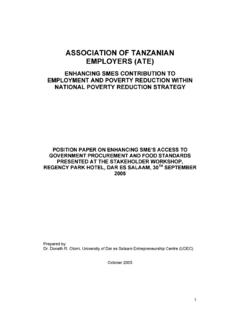Transcription of Drugs and poverty: A literature review - SDF
1 Drugs and poverty : a literature review A report produced by the Scottish Drugs Forum (SDF) on behalf of the Scottish Association of Alcohol and drug Action Teams by: April Shaw, Research Officer, SDF James Egan, Head of Policy and Practice, SDF Morag Gillespie, Research Fellow, Scottish poverty Information Unit, Glasgow Caledonian University March 2007 1 Contents Acknowledgements 2 Executive Summary 3 Drugs and poverty a literature review 6 Introduction 6 literature review 10 Deprivation 10 The causes of problem drug use 11 Lines of causation 11 Communities and social capital 16 Crime and Social Exclusion 19 Welfare Reform 25 Employability 26 Women and drug use 33 Black and Minority Ethnic Groups 37 Rural Areas 39 Policy Implications 41 Conclusion 44 References 45 2 Acknowledgements The authors would like to acknowledge the contribution of Mike McCarron from the Scottish Association of Alcohol and drug Action Teams towards earlier drafts of the literature review .
2 We would also like to thank Christine Goodair, Head of Website and Information Services at DrugScope for her invaluable help at the beginning of the literature search especially for conducting a database search that helped us on our way and thanks to the Scottish poverty Information Unit for lending April Shaw the office space to undertake the database search and reading. Last but not least, thanks to Irene Hendry, Information Officer at the Scottish Drugs Forum, for proof-reading the drafts of this paper. Further enquires contact James Egan at Scottish Drugs Forum or Mike McCarron at the Scottish Association of Alcohol and drug Action Teams 3 Executive Summary What are the links? There are strong links between poverty , deprivation, widening inequalities and problem drug use but the picture is complex. It may involve fragile family bonds, psychological discomfort, low job opportunities and few community resources.
3 Relative poverty , deprivation and widening inequalities, such as income, are important factors that need to be given a more central role within the drug policy debate as they weaken the social fabric, damage health and increase crime rates. Not all marginalised people will develop a drug problem, but those at the margins of society, such as the homeless and those in care, are most at risk. Communities and Crime The Drugs -crime link is not straightforward and three explanations have been put forward - drug use leads to crime; crime leads to drug use; crime and Drugs are related to wider factors. Wider factors include the international drug trade impacting on local communities and also the negative effects of globalisation on local job opportunities. Changing housing markets and policies have had a clustering effect resulting in a concentration of multiple social problems including drug markets within deprived areas.
4 drug markets occur in fragmented local areas but also within highly deprived areas with strong networks. drug markets are economically destructive and damaging but may also bring benefits such as trading in illicit goods (otherwise unaffordable), supplement low incomes and offer personal protection from other criminal activity such as burglary. drug markets may also impair regeneration efforts in areas where there is a lack of job opportunities. The move from a producing to a consuming society may have generated a sense of relative deprivation - stimulating criminal activity in deprived areas among those feeling excluded from a consumer society. Those involved in this type of criminal activity may view it as work that provides an income, a sense of structure and an identity in their daily lives. Governmental drug policy response has involved a shift from public health towards criminal justice priorities.
5 This has resulted in coercive elements being introduced into the health and social care sectors ( drug Treatment and Testing Orders) and 4 care elements introduced into criminal justice sectors ( police custody suites offering needle syringe facilities). Welfare Reform and Employability Scotland s poverty figures are stark. There are 910,000 people experiencing poverty which includes one in four children. Those at risk of poverty change over time while poverty levels among children and pensioners have dropped recently, the levels among working age adults have increased. The main route out of poverty for working-age adults has been a mix of welfare-to-work programmes ( the New Deal) and in-work benefits (tax credits). This response may reduce poverty but it does not eliminate it. drug users face a range of employability barriers including a fear of drug relapse linked to having to renegotiate welfare benefits, restrictive pharmacy dispensing of prescription Drugs and various health, social and criminal justice problems.
6 Structural employability barriers include employer discrimination and a lack of engagement between drug and employment services. Criticism of employability provision includes simplistic targeting within a free market competitive culture of short-term funding an approach at odds with the need to fit in with long-term interventions with problematic drug users. Large scale detachment from the labour-market among problematic drug users may require more preliminary activities being considered - such as confidence-building or improving literacy and numeracy skills before employability programmes. Other areas of concern Black and Minority Ethnic (BME) groups - there are high levels of poverty , deprivation and unemployment among BME groups but the links with problem drug use are even less clear than that of the wider drug using population. Future research into these links needs to acknowledge within its methods an awareness of BME groups.
7 Rural areas - research and policy attention to the links between rural poverty and drug use are sparse and require further attention. Women - a seminal study has shown that far from being mad, sad or bad , women drug users were rational and pragmatic given their life experiences and situations. Nevertheless many lack access to the socioeconomic resources that would help them escape their situations, with poverty one of the main obstacles. 5 Policy implications Re-visiting how we define certain types of drug use and users and seeking out their views could illuminate current policy priorities and responses. For example, the focus on problem drug -using mothers as a group of concern may have resulted in other important areas of child and family concern being overlooked, such as alcohol misuse. To avoiding more clustering of multiple social problems, an increase in public/council housing provision needs to be considered.
8 There is a need to move away from means-tested welfare benefits which stigmatise those unable to take up work. The Drugs -crime relationship requires more attention and needs to take account of the complex relationships involving local drug markets, changes in the housing market, long term unemployment and low benefit levels. There is a need to improve upon the limited welfare claimant figures for people with a drug problem. From a fit to return to work perspective the unfolding Hepatitis C epidemic will present a range of challenges that may require improved working links between the Department of Work and Pensions and NHS services. With kinship carers emerging as a significant care group ( grandparents looking after their grandchildren), there is a need to remedy the postcode lottery approach to financial support for these carers. Reducing inequalities, such as income, may lower high levels of damaging drug use.
9 New policy options are worth considering such as the concept of a Citizen s Basic Income. Policies that focus on reducing poverty , exclusion and inequalities, per se, should help clarify realistic boundaries for health, social care and criminal justice responses to individuals. 6 Drugs and poverty : a literature review There were an estimated 51,582 people with opiate and/or benzodiazepine drug problems in Scotland in 2003 (Hay et al 2005) and the overall unemployment rate of new contacts seeking help from drug services has averaged out at an annual rate of 85% - a stark contrast to the national unemployment rate of Furthermore it has been estimated that 80 - 90% of all Scottish prisoners taken into custody have been misusing Drugs and/or alcohol (Scottish Consortium on Crime and Criminal Justice (SCCCJ) 2002) and that significantly high rates of prisoners come from the most deprived council ward areas (Houchin 2005).
10 Aware of these statistics the Scottish Association of Alcohol and drug Action Teams commissioned this paper to review the literature exploring the links between poverty , social exclusion and problematic drug use. The Scottish Drugs Forum and Scottish poverty Information Unit, supported by the Association also organised a conference in June 2006 to explore the links between Drugs and poverty . Introduction We want now and in the future to see deprivation given its full and proper place in all considerations of drug prevention policy, at both the local and strategic levels, and not let slip from sight. (Advisory Council on the Misuse of Drugs ACMD: drug Misuse & the Environment 1998) This recognition of the importance of the links and relationships between Drugs and poverty came early in the life of the New Labour government. In Scotland, the Scottish Parliament Social Inclusion, Housing and Voluntary Sector Committee held an inquiry into the links between drug misuse and exclusion for individuals, families and communities.









